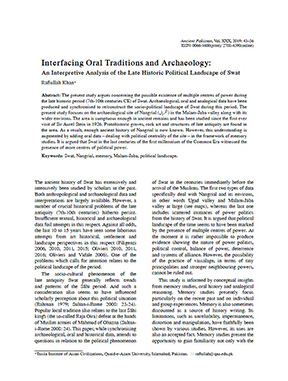Interfacing Oral Traditions and Archaeology
An Interpretive Analysis of the Late Historic Political Landscape of Swat
Keywords:
Swat, Nangrial, memory, Malam-Jaba, political landscapeAbstract
The present study argues concerning the possible existence of multiple centres of power during the late historic period (7th-10th centuries CE) of Swat. Archaeological, oral and analogical data have been produced and synchronised to re/construct the socio-political landscape of Swat during this period. The present study focuses on the archaeological site of Nangrial ( ننگریال ) in the Malam-Jaba valley along with its wider environs. The area is sumptuous enough in ancient remains and has been studied since the first ever visit of Sir Aurel Stein in 1926. Protohistoric graves, rock art and structures of late antiquity are found in the area. As a result, enough ancient history of Nangrial is now known. However, this understanding is augmented by adding oral data – dealing with political centrality of the site – in the framework of memory studies. It is argued that Swat in the last centuries of the first millennium of the Common Era witnessed the presence of more centres of political power.

Downloads
Published
How to Cite
Issue
Section
License
Copyright (c) 2019 Ancient Pakistan

This work is licensed under a Creative Commons Attribution-NonCommercial 4.0 International License.
All Rights Reserved © Department of Archaeology, University of Peshawar




